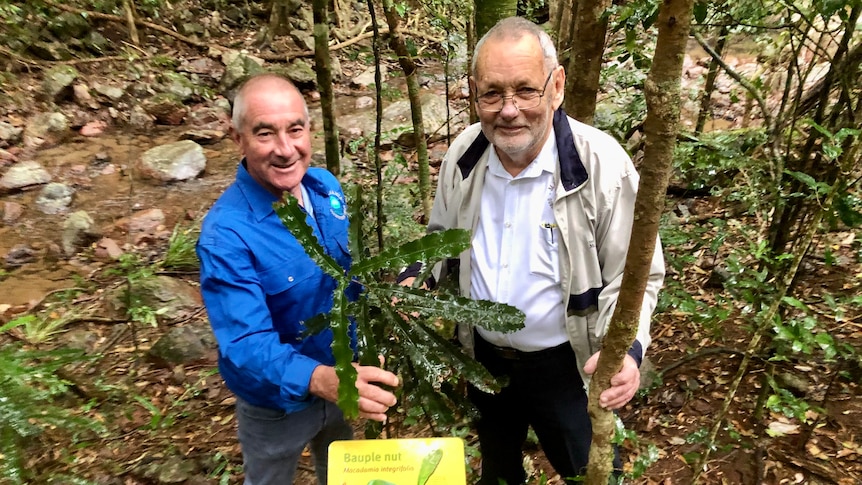The smell hits Kayshun Murray when his chainsaw is almost through the trunk.
Standing in a helmet and steel-capped boots in the West Australian desert, the young ranger inhales a fragrance judged to be among the world’s best.
“You can actually smell all the beauty in it,” he said.
The scent of the sacred sandalwood tree has wafted over Yilka country, more than 1,000 kilometers north-east of Perth, for millennia.
It has long been coveted by international perfume houses and incense makers from New York to Beijing.
Western Australia has harvested the trees and distilled their valuable oil to help meet that demand since 1845.
But Mr Murray and other Yilka traditional owners were only granted a seat at that table a year ago when they received a license to harvest wild sandalwood on their country.
They are determined to retain that right into the future.
Push to ban wild harvest
Calls have been made to ban the harvest of wild sandalwood amid fears it is being pushed towards the brink of extinction.
A law that determines how much can be taken will be reviewed before the end of 2025.
The government will call for public comments about a management program in the coming months.
The driving force behind the Yilka sandalwood operation, known as HM for cultural reasons, said he understood those concerns.
But the Yilka Talintji Aboriginal Corporation chairperson said Aboriginal people should have the opportunity to benefit from industry on their land — as the WA government had for years.
Figures from WA’s Forest Products Commission (FPC) show that total revenue from wild sandalwood is expected to exceed $21 million, excluding costs, in the past financial year.
Yilka secured native title to the Cosmo Newberry reserve in 2017.
That meant, after receiving its harvesting license, it could profit from harvesting the wild tree.
HM said all earnings were invested back into the land after paying rangers’ wages and buying new equipment.
“That way, you don’t have to depend on government,” he said.
‘Regeneration is happening’
HM said his organization hired an external consultant who said a 100-tonne annual wild harvest would be sustainable on Yilka country.
But he said Yilka Heritage and Land Care rangers would instead harvest 60 tonnes, 20 of which would be dead wood.
He said rangers harvested “every second legal tree” from pre-determined lots.
He said they would not return to that lot for 45 years — the time it took for trees to grow.
HM said 20 seeds were thrown down to replace every felled tree.
WA’s Forest Products Commission has attributed the decline of wild sandalwood to the disappearance of small marsupials that buried and dispersed seeds, overgrazing, and reduced winter rainfall rather than harvesting.
It believes regeneration work could help turn things around.
HM said the junior ranger program — made up of school-aged children from Cosmo Newberry — helped with regeneration by measuring, photographing, and recording the coordinates of pulled and planted trees.
“So when we go for our next license we can prove to the government that all this regeneration is happening from where we pulled last year,” HM said.
social sustainability
The harvested sandalwood is taken to Dutjanh Sandalwood Oil’s distillery in Kalgoorlie where oil is extracted and sold to the international fragrance market.
Distillery chief executive Guy Vincent, who recently returned from the World Perfumery Congress in Miami, said a combination of cultural stewardship and scientific expertise was key to ensuring the wild sandalwood industry was sustainable.
Mr Vincent also said Dutjanh, who was half-owned by Aboriginal Australians and invested about 30 per cent of earnings back into communities, and Yilka had clear commitments towards social sustainability.
But he said the industry needed to do more in that space.
“Purchasing the wood through groups like Yilka is economically and socially sustainable because we have our benefit sharing,” Mr Vincent said.
“[But] we’re a very rare case in the industry.”
The WA government recently appointed an Aboriginal Sandalwood Advisory Group to help increase First Nations’ involvement in the industry.
It said it increased the wild sandalwood quota available for Aboriginal people seeking a license last year while reducing the FPC’s quota.
It also said social sustainability was among the criteria that wild harvest sandalwood quantities would be reviewed again by 2026.
‘You can walk in freedom’
Ranger Lyall Westlake said he felt at peace on country.
“The land is really perfect,” he said, standing under rain clouds on the Great Central Road.
“You can smell the breeze. Smell the wind.”
He said it was different from in town where there were more cars and people.
“You don’t know who is coming and going,” he said.
“But here you can walk in freedom.”
Fellow ranger Gwenetta Westlake said she loved working with her younger sibling, Chelsea.
“She always chases me, wherever I go because she’s my baby sister,” she said.
The Cosmo Newberry residents are among the 45 rangers HM has on the books to manage the sandalwood operation, as well as cool burns and care for cultural sites.
HM said the work provided alternative jobs to the local mining industry and was a better fit culturally for many of those involved.
He said a well-managed industry could pave the road to a better future for many residents.
“Looking after country is the most important thing for us,” he said.
“If we don’t, we don’t exist.”
.

